This article may contain affiliate links. If you make a purchase after clicking on a link we may earn a small commission at no extra cost to you. As an Amazon Associate, I earn from qualifying purchases.
How to Catch Trout for Beginners
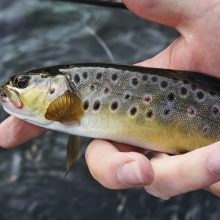
Trout fishing is one of the most popular forms of fishing in the world, but it requires a very unique approach in order to truly be successful.
Some of the most popular game fish species in North America are relatively easy to catch. Simply place a worm on your hook, throw it into the water and wait.
Trout fishing, on the other hand, requires a bit more effort and determination.
Targeting a fish that’s more elusive is part of why so many anglers love trout fishing. But don’t let this new challenge discourage you from embarking on your first trout fishing trip. Here are some of the best trout fishing tips for beginners that will help you get started.
Trout Fishing
There are six major trout species that are native to the North American continent. Each of these fish are known to be ferocious fighters who thrive in cool, clear water—which is why trout can usually be found hidden away in mountain streams, deep into the wilderness.
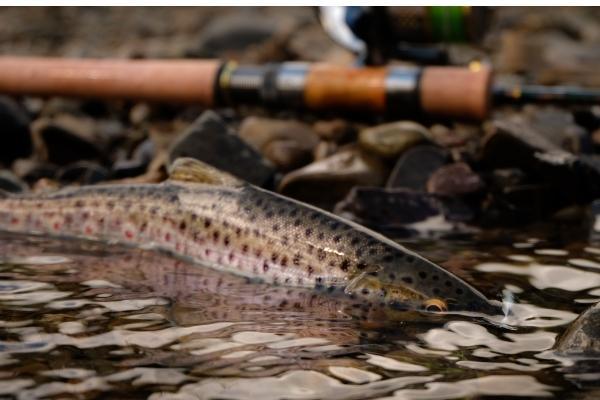
Trout have exceptionally good eyesight compared to other game fish species. Their keen eyesight, coupled with their usual habitat of crystal clear water means that they can usually spot when something doesn’t appear to be natural. Other fish rely more heavily on smell to detect prey, but trout rely heavily on their vision.
Trout can also be very picky eaters, passing up other meals that most fish would devour without a second thought.
They usually feed on just about any kind of natural insect or other critter that makes its way into the water.
Flies and insects are a favorite cuisine, so most trout anglers will opt to use artificial flies and small worms or crickets as bait.
These fish are also fun to catch because of their reputation for fighting hard once they’ve been hooked. Even a small trout can require a surprising amount of effort to land.
Their bodies are long and slender, which gives them the ability to swim fast and hard in short bursts instead of slowly pulling on the line like other game fish species.
Where to Catch Trout?
This is one of those trout fishing tips that may vary depending on the particular geographical location you’re in. Some trout can be found in lakes, but the vast majority of trout are found in rivers and streams.
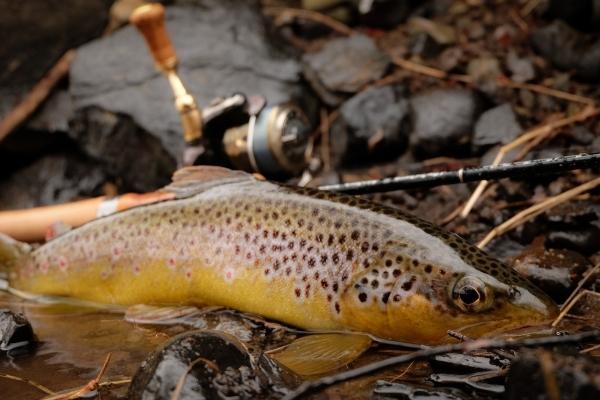
Trout can sometimes be naturally-occurring in certain areas, or stocked by wildlife management organizations.
- Stocked trout – are known to be fairly easy to catch as they have been raised to eat whatever comes their way without having to worry about many predators.
- Wild trout – however, are highly cautious and much more skittish than their tame cousins.
Trout like to stay in fast-moving water that is well-oxygenated. Look for rough spots in the water, or places where there are small “rapids” as these are more likely to be home to small minnow and are ideal locations for trout to hangout.
Sometimes, trout will congregate in runs where the river becomes more narrow and deep.
- Runs – are great to fish as trout usually have a harder time spotting approaching predators due to the increased depth.
- Pools – or sections of creeks and streams where the water has slowed down and deepened, are another great location for this reason.
Trout also love to stay in or around bends in a creek or river as this is a great spot for them to set up and have a good vantage point for any potential meals floating downstream.
Also, look for trout in areas where two streams intersect or meet as this will provide ample oxygen and better chances that they’ll find food.
What to use to catch trout?
When it comes to the best trout fishing setup, most beginner anglers are encouraged to use a lightweight or ultralight spinning reel combo.
These are simple to use and require a lot less time to learn and become familiar with than a fly rod.
A good choice spinning reel for trout would be a size 2000 reel that you would pair with a trout rod of roughly 6 feet in length with an ultralight power rating and a fast action.
Remember, trout have great eyesight, so you’ll want to use a lighter fishing line that they won’t be able to see underwater.
It’s usually recommended to use fluorocarbon line that’s between 4 and 8 pound test. Anything heavier than 8 pound test line will probably be visible to trout and they are very unlikely to bite your lure or bait.
What kind of bait or lure should I use?
Artificial baits are very effective for trout, but it’s recommended that beginners start with some kind of smaller live bait when they first start.
Using live bait doesn’t require you to do anything more than cast your bait into the water and let the current carry it down to the specific location where trout are hanging out.
Wax worms, crickets, nightcrawlers and even small minnows are often great choices for trout fishing. Don’t use an oversized hook as this will once again put you in danger of being spotted by a trout. Using a size 8-12 hook is usually best for beginner trout anglers.
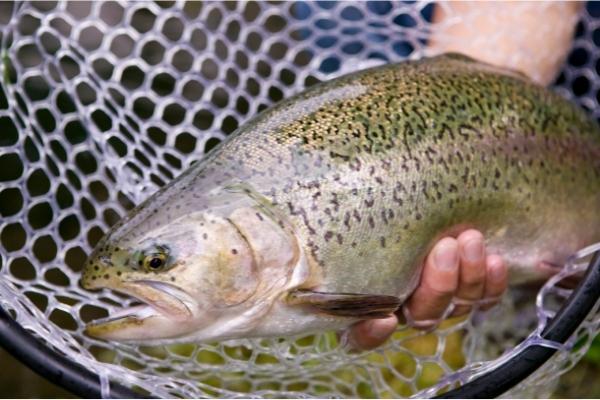
Artificial lures also work very well for trout fishing. These might require just a bit more experience to understand just how to use them, but knowing when and where to use a specific kind of bait will lead to catching more fish.
A rooster tail is a great artificial trout lure as the small, rotating spoon will catch the attention of any nearby trout. In-line spinners, or small and slender minnows and jerkbaits are also great choices for trout lures that will work in a variety of different circumstances.
How to Catch Trout
There are a variety of different ways to catch trout, with some methods working better in certain parts of the country.
For beginners, there are three basic trout fishing methods that are easy to learn and will allow you to catch fish more quickly than other methods.
1. Bottom fishing
This method is the easiest trout fishing method and is often used by seasoned anglers when the water is slow-moving and the fish are having trouble biting. Live bait is often the best choice for bottom fishing, but some artificial baits will also be productive.
Anglers will want to throw their bait into the water and allow it to sink to the bottom. It’s very important to keep your line tight and let your bait remain as still as possible to avoid spooking any fish that come to investigate.
Watch your line and pay attention to small bumps as this usually indicates that a trout is biting your hook.
2. Drifting
This method of trout fishing lets you use the water’s current to carry your bait to the right spot. Drifting typically requires a certain amount of patience as many anglers might become tired of constantly reeling in and throwing into the same spot over and over.
The key here is to cast your bait upstream from the point where you expect the trout to be and allow your bait to float in the current without interfering in it’s course. You’ll want to keep an eye on your bait when drift fishing, and it can sometimes be hard not to lose sight of your lure, especially in strong currents.
3. Bobber Fishing
This method is wildly popular with most other common game fish species like crappie, bass and bream. Simply rig your bobber about a foot above your lure (depending on the water’s depth) and cast it into the area where you expect trout to be staging.
Be sure to use a small bobber that won’t be easily noticed by trout. The key to bobber fishing for trout is to watch your bobber closely. Trout can sometimes bite your hook without ever pulling the bobber under. If you think you’re getting a bit, gently pull up on your rod to check and make sure a trout hasn’t taken your bait.
There are many different kinds of baits you can use when bobber fishing for trout and this is a great way to introduce youngsters to the sport.
When to Fish for Trout
Spring is considered to be the best time of the year for trout fishing, especially for beginners. Cold weather makes trout lethargic, but warmer temperatures will mean warmer water and more active trout.
Another reason why trout love springtime is that an abundance of bugs and insects will emerge from their winter hideouts, meaning trout see spring as a time to feed and recover from a long, hard winter.
Trout fishing in the spring can often be hit or miss due to weather fluctuations. Watch the forecast and wait for a prolonged warming period to move in as this will be the best time for trout fishing.
Summer is also great for trout fishing as there will be plenty of food for trout. Be aware that when hot temperatures move in, trout will usually feed less, making them very difficult to catch.
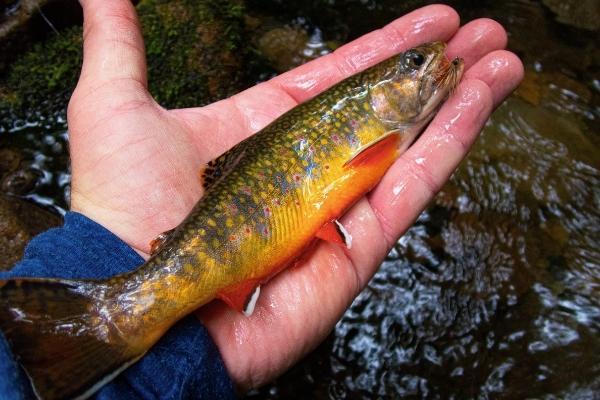
The autumn season is often good for trout fishing early on as newer, cooler temperatures are met with enthusiasm from trout who will become more active when the temperature drops. However, the closer it gets to winter, the less active trout will be.
Winter is not a great time to go trout fishing, but that doesn’t mean that you can’t catch them during the colder months.
Only the most dedicated anglers fish for trout in the winter, but it is a good time to avoid the spring and summer crowds while enjoying the beauty of nature.
For some southern states, winter is an ideal time for trout fishing because temperatures may not dip down near the freezing mark long enough to discourage the fish from feeding regularly.
How to Handle Trout
Be very careful with any trout that you do catch because the slightest injury can easily kill the fish. Trout are made for the water and the longer they are on dry land means their chances of survival are decreasing.
Most anglers who practice catch and release with trout will never take them fully out of the water. Instead, they will get a hand on the trout while it is still in the water and gently remove the hook.
If you want to snap a quick photo, simply lift the trout out of the water and make it quick. Have your camera ready before taking the trout out of the water.
Trout can be especially slippery, but it’s crucial to not squeeze them very hard as this will undoubtedly cause internal damage and lead to death. Be sure to follow the advice of the experts when it comes to safely handling and releasing trout. Learning how to revive a trout before fully releasing it is also another step that will go a long way to ensure its survival.
Trout Fishing Rules and Regulations
It’s very important that you become familiar with all the laws and regulations pertaining to trout in the specific area you plan to fish.
For some states, an angler only needs to purchase a fishing license in order to legally trout fish. But in other states, anglers must purchase a fishing license, as well as a trout stamp or specialized trout fishing license.
Be sure to research and ask about any trout fishing guidelines that should be followed in the place you plan to fish.
Many states have laws against using certain kinds of bait, while some areas have outlawed the use of barbed hooks. Following the rules is essential as this ensures that everyone can safely enjoy trout fishing for many years to come.
Conclusion
We hope these trout fishing tips tips for beginners will be helpful to everyone who is interested in learning more about one of North America’s greatest game fish species.
Trout fishing might seem tough at times, but taking a careful and thorough approach will eventually lead to success.
Once you’ve mastered the tips included in this guide, you’ll be ready to share your own bits of wisdom with newcomers and help others to catch trout!
